What is ADR in Film? A Comprehensive Guide to Automated Dialogue Replacement
|
5 mins
|
Apr 23, 2025

- The Indispensable Role of ADR in Filmmaking
- A Detailed Look at the ADR Process
- Scenarios Where ADR Becomes a Necessity
- The Impact of Well-Executed ADR on the Audience Experience
- Technological Advancements in ADR
- The Collaborative Roles in the ADR Process
- Best Practices and Considerations for Seamless ADR
- Cost and Time Implications of ADR
- Notable Examples of Films Where ADR Played a Crucial Role
- Future Trends and Potential Innovations in ADR Technology
- Conclusion
- Spotlight FX - Get free transitions, effects and workflow tools
ADR, short for Automated Dialogue Replacement (and also known as Additional Dialogue Recording or looping), represents a critical stage in the post-production process of film and television. It involves the re-recording of dialogue by actors in a controlled studio environment after the initial filming has been completed. This meticulous process ensures that the final audio track of a production is clear, consistent, and serves the narrative effectively.
The Indispensable Role of ADR in Filmmaking
While filmmakers strive to capture perfect sound on set, the reality of production often presents numerous obstacles. The dynamic and often unpredictable nature of filming locations, coupled with the technical complexities of sound recording, frequently leads to dialogue tracks that are less than ideal. This is where ADR steps in as a vital solution, offering the opportunity to refine and, when necessary, completely replace the original audio. Without ADR, many films would suffer from distracting background noise, inconsistent audio levels, or even unintelligible dialogue, significantly hindering the audience's engagement with the story.
A Detailed Look at the ADR Process
The ADR process is a carefully orchestrated series of steps that require precision and collaboration among various members of the production team:
- Preparation and Scheduling: Once the initial cut of the film is nearing completion, the sound department, in consultation with the director and editor, identifies scenes where ADR is required. This involves meticulously reviewing the original dialogue tracks and noting any issues or desired changes. Actors who need to re-record their lines are then scheduled for ADR sessions.
- Studio Setup: An ADR studio is a soundproofed environment equipped with high-quality microphones, headphones for the actor, and a screen to project the corresponding footage. The setup ensures optimal recording conditions, free from external noise interference.
- Cueing and Synchronization: A crucial aspect of ADR is ensuring that the re-recorded dialogue perfectly synchronizes with the actor's lip movements on screen. ADR editors create "cues" for each line of dialogue, marking the precise start and end points. These cues are often visual, such as wipes or beeps, that the actor can follow while recording.
- Actor Performance: During the ADR session, the actor watches the scene repeatedly through headphones that play back the original production audio (as a reference) and the visual cues. They then re-perform their lines, aiming to match the timing, intonation, and emotional nuances of their original performance, while also incorporating any new direction from the director.
- Technical Recording: The ADR technician meticulously records the actor's performance, paying close attention to microphone placement and sound levels to achieve the best possible audio quality. Multiple takes of each line are often recorded to provide options for the sound editor.
- Editing and Sweetening: After the recording session, the ADR editor selects the best takes and meticulously edits them to fit seamlessly into the film's soundtrack. This involves synchronizing the new dialogue with the picture, ensuring smooth transitions, and adjusting the audio levels and equalization to match the surrounding sound. This stage is often referred to as "sweetening."
- Mixing: Finally, the ADR tracks are integrated into the overall sound mix of the film, along with music, sound effects, and other dialogue. The mixing stage ensures that all audio elements work harmoniously to create a cohesive and immersive auditory experience for the audience.
Scenarios Where ADR Becomes a Necessity
The use of ADR is not limited to fixing technical issues. It serves a variety of crucial purposes in filmmaking:
- Eliminating Poor On-Set Audio: As mentioned earlier, unwanted noises from the environment, such as traffic, wind, or equipment hum, can contaminate the original dialogue recording, making ADR essential for clarity.
- Overcoming Technical Malfunctions: Microphone failures, recording errors, or damaged audio files can necessitate the re-recording of entire scenes.
- Enhancing Performance and Delivery: Directors may realize after reviewing the footage that certain lines could be delivered with a different emphasis, emotion, or pace to better serve the story. ADR provides the opportunity for actors to refine their performances.
- Adding Clarity and Understanding: In some cases, dialogue recorded on set might be mumbled or unclear. ADR allows actors to re-articulate their lines for improved audience comprehension.
- Incorporating New or Revised Dialogue: During the editing process, filmmakers may decide to add, remove, or modify lines of dialogue to enhance the narrative flow or provide additional information. ADR facilitates these changes seamlessly.
- Facilitating Foreign Language Dubbing: For international distribution, ADR is extensively used to record actors speaking the dialogue in various languages, ensuring the film reaches a wider audience. While lip-syncing can be challenging, skilled dubbing actors strive to match the original performance as closely as possible.
- Creating Voice-Overs and Narration: ADR studios are also used to record voice-over narration that provides context, explains events, or offers insights into characters' thoughts.
- Replacing Dialogue Affected by Special Effects: Sometimes, on-set dialogue might be obscured or altered by practical or visual effects, requiring ADR to restore clarity.
The Impact of Well-Executed ADR on the Audience Experience
When ADR is executed flawlessly, it becomes an invisible art form. The audience remains completely immersed in the story, unaware that some or even a significant portion of the dialogue was re-recorded. Clear and well-delivered dialogue is fundamental to conveying plot points, character development, and emotional nuances. Conversely, poorly executed ADR can be distracting and jarring, pulling the audience out of the film's reality due to noticeable discrepancies in lip-sync, audio quality, or performance. Therefore, the meticulous attention to detail in the ADR process is crucial for maintaining the integrity of the cinematic experience.
Technological Advancements in ADR
Over the years, ADR technology has evolved significantly. Early methods involved cumbersome looping techniques, where short segments of film were played repeatedly for the actor to synchronize with. Modern ADR utilizes sophisticated digital audio workstations (DAWs) and software that provide precise visual and auditory cues, streamlining the process and allowing for greater flexibility in editing and synchronization. Advancements in microphone technology and recording techniques have also contributed to the improved quality and seamless integration of ADR dialogue.
The Collaborative Roles in the ADR Process
Successful ADR relies on the collaborative efforts of several key individuals:
- The Director: Provides guidance to the actors on performance and ensures the re-recorded dialogue aligns with their vision for the scene.
- The Actor: Re-performs their dialogue, matching their original performance while incorporating any new direction.
- The ADR Director/Supervisor: Oversees the ADR sessions, ensuring the actor's performance and technical aspects meet the required standards.
- The ADR Editor: Creates cues for the actor, manages the recording process, and performs the initial editing and synchronization of the dialogue.
- The Sound Editor: Integrates the ADR tracks into the overall sound design of the film, ensuring consistency in audio quality and levels.
- The Re-recording Mixer: Balances the levels of dialogue, music, and sound effects, including the ADR tracks, in the final mix.
Best Practices and Considerations for Seamless ADR
Achieving seamless ADR requires careful planning and execution:
- Early Identification of ADR Needs: Identifying scenes requiring ADR early in the post-production process allows for efficient scheduling and avoids last-minute rushes.
- Detailed Cueing: Precise and clear visual and auditory cues are essential for actors to accurately synchronize their performance.
- Actor Comfort and Performance: Creating a comfortable and supportive environment for the actors is crucial for eliciting natural and nuanced performances during ADR sessions.
- Matching Original Performance: Actors should strive to replicate the emotional tone, pace, and physicality of their original on-set performance. Providing them with ample context and reference footage is vital.
- Attention to Lip Sync: While perfect lip-sync is the goal, subtle variations can sometimes be unavoidable. Skilled ADR editors can often manipulate the timing of the audio to minimize any noticeable discrepancies.
- Audio Quality Consistency: Matching the acoustic characteristics of the ADR recordings to the original production audio is essential for a seamless blend. This involves careful microphone selection and processing.
Cost and Time Implications of ADR
ADR can be a significant expense and time commitment in post-production. The cost depends on factors such as the number of actors involved, the amount of dialogue to be re-recorded, the studio rental fees, and the time required for recording, editing, and mixing. Efficient planning and clear communication can help manage these costs and timelines effectively.
Notable Examples of Films Where ADR Played a Crucial Role
Many critically acclaimed and commercially successful films have relied heavily on ADR to overcome production challenges or enhance the final product. While it's often an invisible process, its impact on the clarity and emotional resonance of these films is undeniable. Specific examples are often not widely publicized, as the goal is seamless integration, but industry professionals understand its pervasive role. Films with challenging on-location shoots or those requiring extensive dialogue revisions often rely significantly on ADR.
Future Trends and Potential Innovations in ADR Technology
The field of ADR continues to evolve with advancements in technology. Virtual reality (VR) and augmented reality (AR) could potentially offer new ways for actors to immerse themselves in the original filming environment during ADR sessions, potentially leading to more natural and nuanced performances. Artificial intelligence (AI) and machine learning might also play a role in automating certain aspects of the ADR process, such as initial synchronization or audio cleanup, although the creative input of actors and sound professionals will remain essential.
Conclusion
ADR, or Automated Dialogue Replacement, is a fundamental and often unsung hero of the filmmaking process. It provides filmmakers with the crucial ability to refine, replace, or enhance dialogue, ensuring that the story is communicated clearly and effectively to the audience. While the process itself is technical and demanding, the ultimate goal of seamless integration allows viewers to remain fully immersed in the world of the film, oblivious to the intricate work that went into crafting the final soundtrack. As technology continues to advance, ADR will undoubtedly remain an indispensable tool for cinematic storytelling.
Denis Stefanides
About the author
Related Posts

Denis Stefanides
13 mins

Denis Stefanides
11 mins

Denis Stefanides
10 mins
